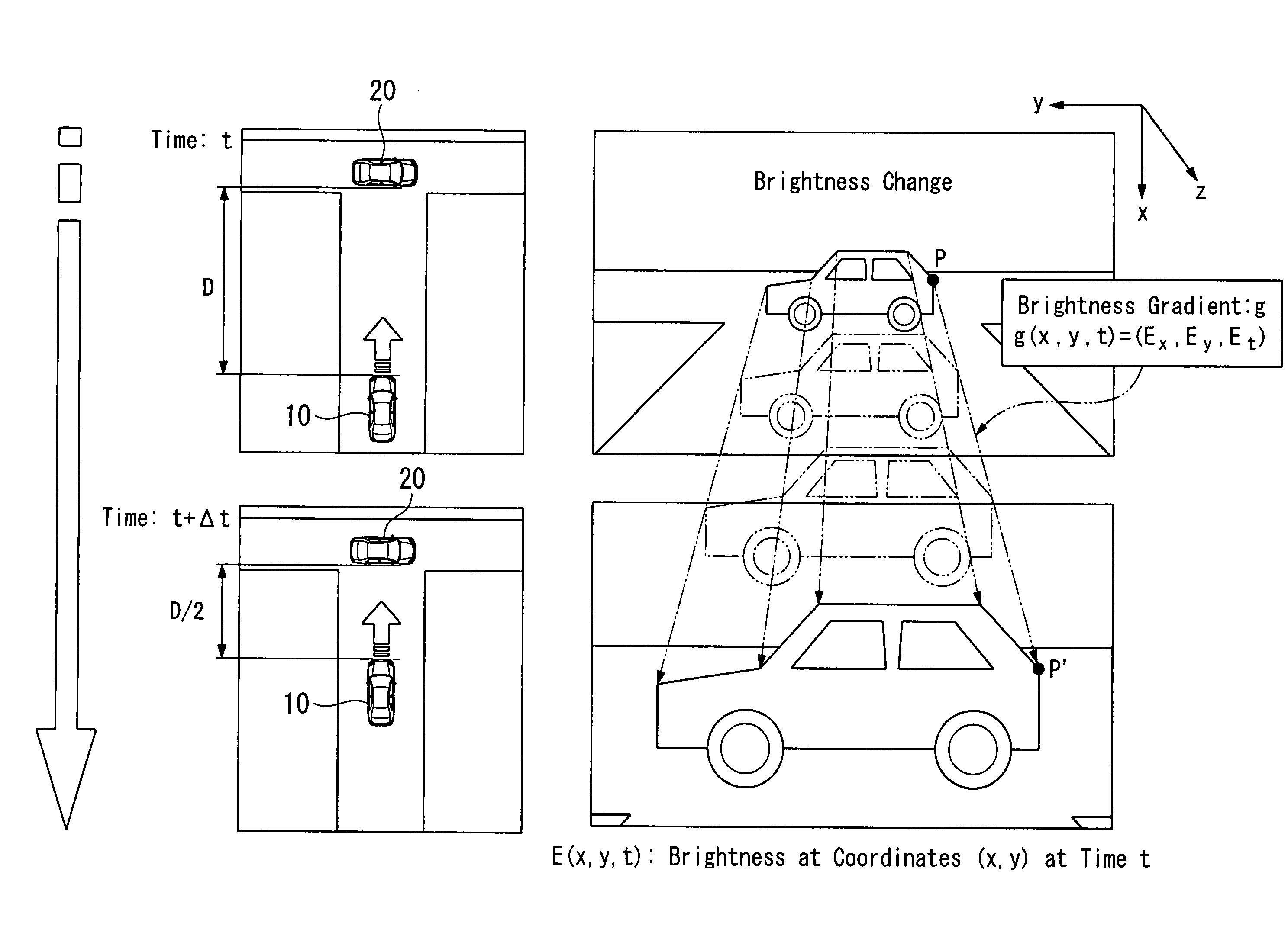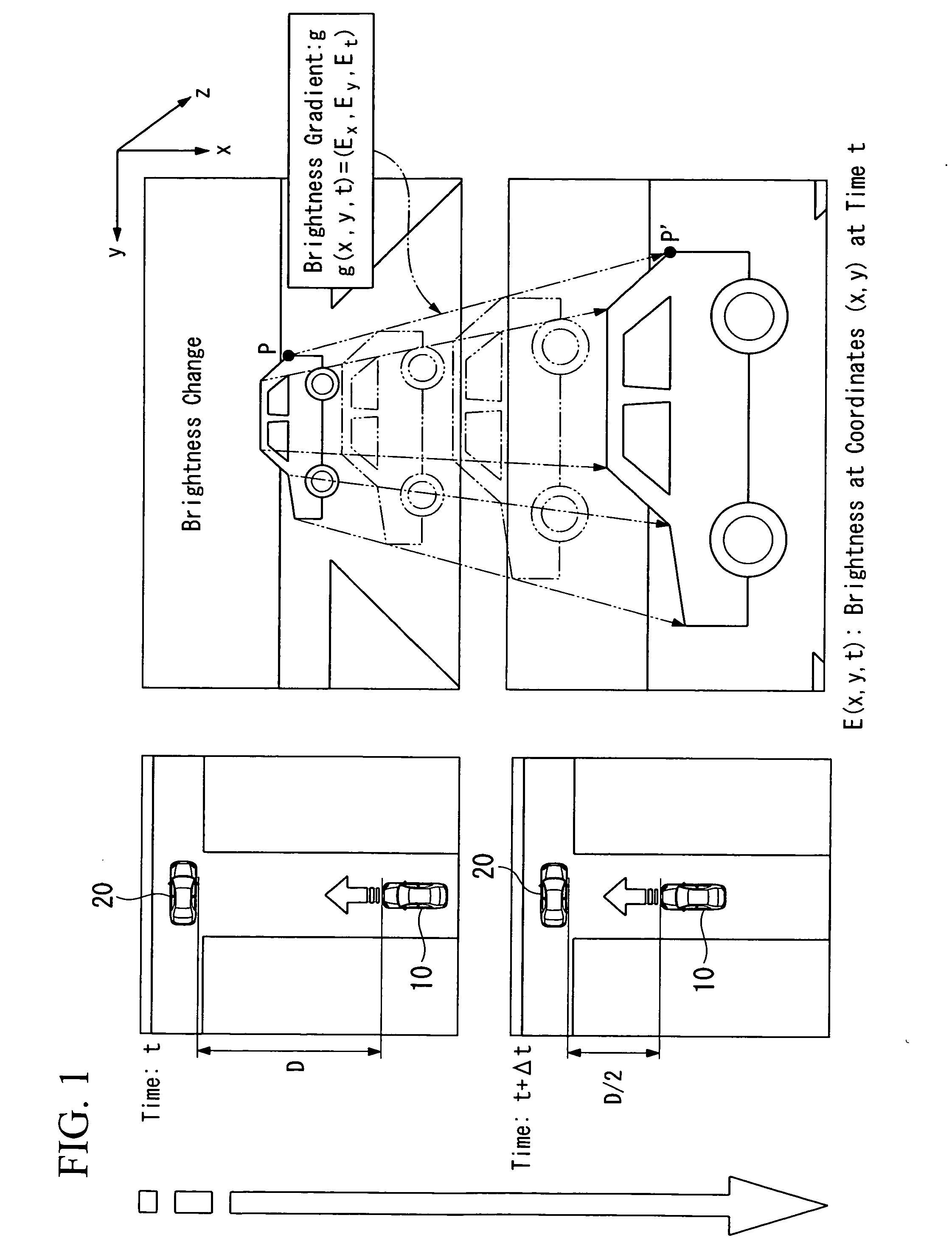Time-to-contact estimation device and method for estimating time to contact
a technology of which is applied in the field of time-to-contact estimation device and time-to-contact estimation method, can solve the problems of low accuracy, high cost, and limited application, and achieve the effect of low latency and computation
- Summary
- Abstract
- Description
- Claims
- Application Information
AI Technical Summary
Benefits of technology
Problems solved by technology
Method used
Image
Examples
case 1
[0071]In Case 1, as shown in FIG. 7, a translational motion of the camera 2 along a translation path 3, which is in parallel with the optical axis 2a of the camera 2 in this case, toward the planar surface 1 fixed perpendicular to the optical axis 2a (i.e., the normal 1a of the planar surface 1 is in parallel with the optical axis 2a and the translation path 3) is discussed. In this case, because the degrees of freedom of the planar surface 1 and the camera 2 are constrained, i.e., the camera 2 moves along the optical axis 2a thereof without rotational motion, the brightness gradient constraint equation is the simplest form. In addition, by assuming that the object to be considered is a planar surface that is oriented perpendicular to the optical axis 2a of the camera 2, motion vector (u,v) in the image (u=dx / dt, v=dy / dy) can be simply expressed as follows,
u=x(W / Z), v=y(W / Z) C1-(1)
and the time to contact TTC is expressed as follows,
TTC=Z / W C1-(2)
where W is speed of the camera 2 ...
case 2
[0086]In Case 2, as shown in FIG. 8, a translational motion of the camera 2 along a translation path 3, which is arbitrarily determined in this case, toward the planar surface 1 fixed perpendicular to the optical axis 2a (i.e., the normal 1a of the planar surface 1 is in parallel with the optical axis 2a) is discussed. In this case, the degree of freedom of the planar surface 1 is constrained, and the degree of freedom of the camera 2 is not constrained, i.e., the camera 2 moves not necessarily along the optical axis 2a, or not necessarily along a line in parallel with the normal 1a of the planar surface 1. U, V, and W shown in FIG. 2 respectively indicate X, Y, and Z component of velocity in the sensor oriented coordinate system. With regard to these terms, following Equation C2-(1) (i.e., brightness gradient constraint equation) is satisfied, where f is focal length of the camera 2.
u=−f·U / Z+x·W / Z, v=−f·V / Z+y·W / Z C2-(1)
It should be clear that Case 1 discussed above is simply a sp...
case 3
[0101]In Case 3, as shown in FIG. 9, a translational motion of the camera 2 along a translation path 3, which is in parallel with the optical axis 2a of the camera 2 in this case, toward the planar surface 1 of an arbitrary orientation (i.e., the normal 1a of the planar surface 1 is not necessarily in parallel with the optical axis 2a) is discussed. In this case, the degree of freedom of the camera 2 is constrained, and the degree of freedom of the planar surface 1 is not constrained.
[0102]When p and q are defined to be the slopes in the X and Y direction of the planar surface 1 measured in the imaging system coordinate system, the planar surface 1 is expressed by the following Equation C3-(1).
Z=Z0+pX+qY C3-(1)
X=Z·x / f and Y=Z·y / f are substituting into Equation C3-(1) to obtain following Equation C3-(2).
[0103]
Z(1−p(x / f)−q(y / f))=Z0 C3-(2)
By using the relationship among brightness, these motion vector constraint equations can be expressed by following Equation C3-(3).
[0104]
rEr(1−p·...
PUM
 Login to View More
Login to View More Abstract
Description
Claims
Application Information
 Login to View More
Login to View More - R&D
- Intellectual Property
- Life Sciences
- Materials
- Tech Scout
- Unparalleled Data Quality
- Higher Quality Content
- 60% Fewer Hallucinations
Browse by: Latest US Patents, China's latest patents, Technical Efficacy Thesaurus, Application Domain, Technology Topic, Popular Technical Reports.
© 2025 PatSnap. All rights reserved.Legal|Privacy policy|Modern Slavery Act Transparency Statement|Sitemap|About US| Contact US: help@patsnap.com



